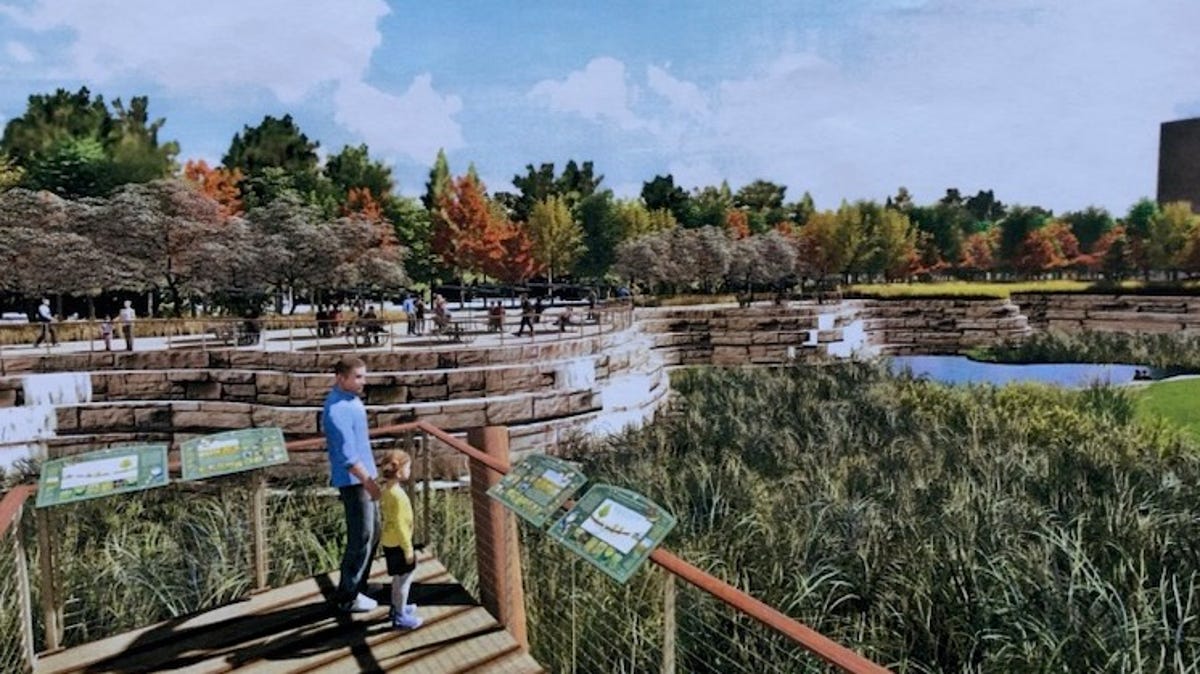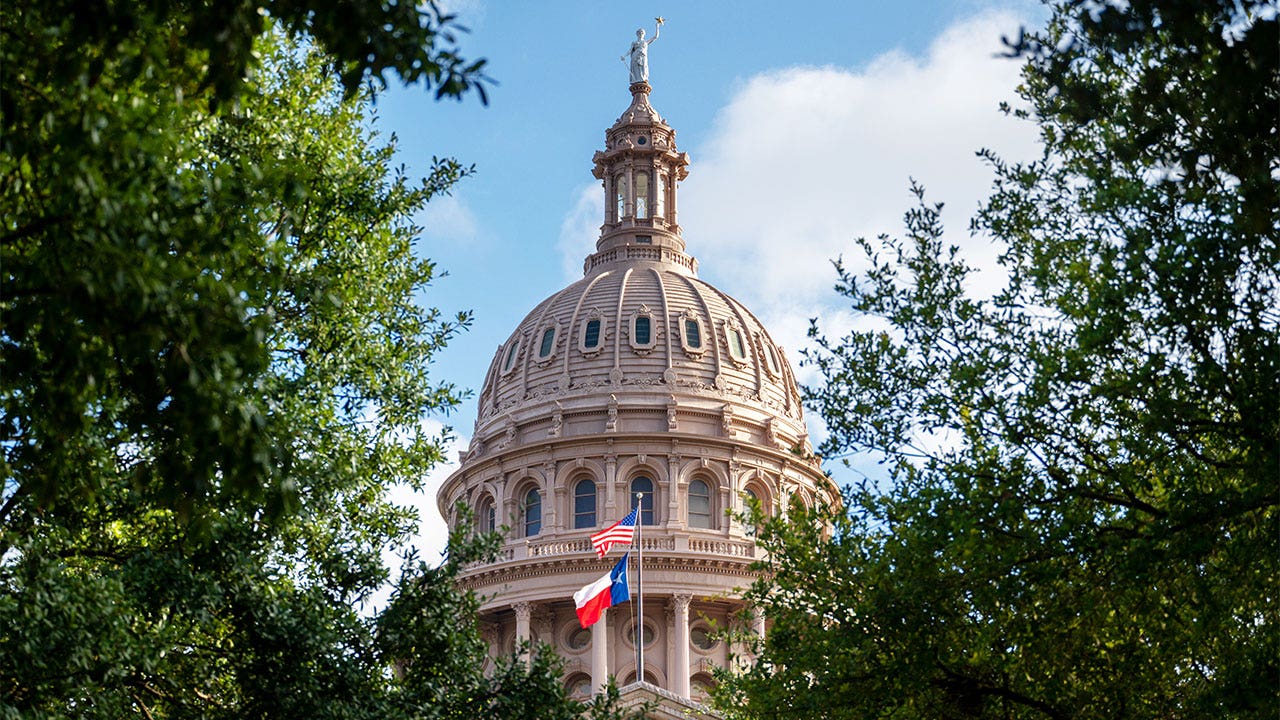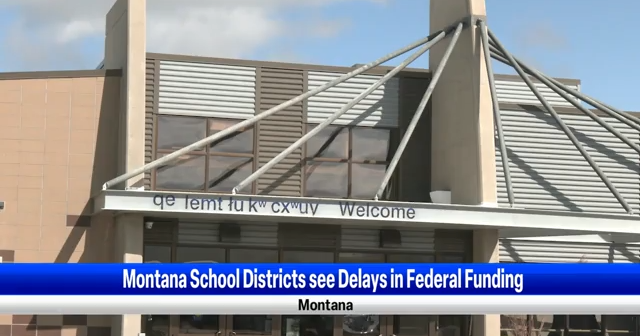Michigan
‘Park Michigan’ concept could create state mall west of Capitol

LANSING — An expanse of parking between Michigan Hall of Justice and offices occupied by state workers could transform into a green space featuring monuments and performance areas under a conceptual plan from the Michigan State Capitol Commission.
“This proposal is conceptual at this point,” Commission member John Bollman said Friday. “While we are excited about the concept, there are still a number of steps that need to take place before we can proceed.”
The concept — called Park Michigan — would replace a large parking area east of the Hall of Justice, west of the Ottawa and Hannah office buildings, and between Ottawa and Allegan streets and provide a connection east to the Michigan Capitol building.
Lansing Mayor Andy Schor said he backs the opportunity to transform a sea of lightly used parking into green space.
“I am fully supportive, and would love to see this space turned into park space for all Lansing residents and visitors to enjoy,” he said via email. “It would be wonderful to have a state park in the heart of our city, and to take out some of the surface parking lots, as we have so many.”
Since the COVID-19 pandemic, fewer state workers travel to Lansing on any particular day. Many of those who previously parked in the targeted lots now work fully remote or hybrid schedules.
“If we can’t have state employees back, then we don’t need all that parking. A great alternative use is a park or development, and we would certainly like to see both,” Schor said.
Memorials honoring Michigan Vietnam veterans and law enforcement officers sit at the southwest corner of the parking lot while a small area of green space remains in the northwest section of the area.
In addition to the existing monuments, the plan would feature a “We The People Plaza” providing 360-degree views of the park, including views of the state’s executive office buildings, the “exquisitely restored Michigan State Capitol Building,” the Hall of Justice, the Michigan Library and History Center and, to the north, “features representing Michigan’s abundance of beautiful natural resources.”
An outline of the proposal also notes the park will include a monument commemorating the upcoming 250th anniversary of America, an amphitheater for concerts and presentations, plantings of native species, a sculpture garden, and historical markers and educational kiosks.
“The park landscape, with its walkways, gardens, and benches, will also be a place to enjoy a beautiful setting, to relax, to gather and to be inspired,” the proposal suggests.
The park will connect to the Capitol by way of the existing Frank J. Kelley Walkway. In addition, a non-motorized path will connect the park to the Lansing River Trail.
“This new park will not only provide a symbolic and physical connection between the state’s legislative, executive and judicial branches, but it will provide a connection to the state’s cultural and natural history, as well,” the proposal suggests.
Commission documents compare the proposal to the national mall in Washington, D.C. Bollman said the Bicentennial Capitol Mall State Park in Nashville is “a great example” and “potential model” of what the commission has in mind.
The Tennessee park fronts the state capitol, the state museum and a farmers market, and also includes veterans memorials, historical markers and a bell carillon that rings hourly with songs, including “The Tennessee Waltz.
The conceptual plan says the Michigan park will be developed as a public/private partnership, but once completed, it will be maintained by the Michigan State Capitol Commission.
Bollman said the concept is only beginning to be considered and a variety of details need to be worked out before it can become a reality.
“We do not have final cost projections at this time,” he said. “While we would like to see this project developed as a public/private partnership, we have not yet started lining up project partners. We also need to address the current site usage with other state agencies before we can proceed.”

Michigan
Michigan Sportswatch Daily Listings

Michigan State at Indiana — Big Ten Plus
Michigan at Oregon — Big Ten Plus, Fox Sports App, Fubo Sports US
Chicago at Detroit — CHSN Plus, FDSN Detroit, Fubo Sports US
Florida at Detroit — truTV, Max, TNT WEB
The Associated Press created this story using technology provided by Data Skrive TV listings provided by LiveSportsOnTV.
Michigan
Michigan launches loan repayment program for nurses: What to know

Student loans no longer handled by Education Department, Trump orders
President Trump ordered student loans out of the Education Department. He’s asked the Small Business Administration to manage it.
- The Michigan Department of Health and Human Services is offering up to $300,000 in student loan repayment to eligible nurses.
- The program aims to incentivize nurses to work in underserved communities facing staffing shortages.
- Applications are open until June 4th and can be found on the Michigan.gov/NLRP website.
Hoping to increase the number of nurses in underserved communities, the Michigan Department of Health and Human Services (MDHHS) is launching a student loan repayment program for qualified nurses, up to $300,000.
The Nurse Loan Repayment Program (NLRP) will pay up to $300,000 per nurse, up to four years for nurses working in psychiatric facilities, or up to 10 years for nurses working at other eligible facilities.
There is about $9 million available for student loan repayment.
“Nurses are the backbone of the health care system, providing essential care to patients in hospitals, clinics, schools and homes,” Elizabeth Hertel, MDHHS director, said in a news release. “They are often the first point of contact for patients and play a critical role in patient education, advocacy and support. Health care facilities across the state are facing nursing shortages and this loan repayment program will help providers recruit and retain nurses to provide vital care to patients.”
Applications are available at Michigan.gov/NLRP, and the deadline is Wednesday, June 4.
Who qualifies for loan repayment?
To be eligible for the loan repayment program, Michigan nurses will need to work at least 40 hours a week for at least 45 weeks a year at eligible nonprofit practice sites that provide nursing services or full-time for nurses in public school settings or who teach at a school of nursing.
How does the program work?
Nurses and employers will enter into two-year agreements in which the employee must remain with the employer for the duration of the contract.
Nurses can compete for consecutive two-year agreements for repayment, according to the state’s health department.
How many healthcare workers are there in Michigan?
More than 1 million Michiganders work in the healthcare industry, according to the Michigan Health and Hospital Association.
Nearly 572,000 Michigan residents hold direct patient care jobs and provide medical or supportive care to patients.
An additional 502,000 Michiganders work in indirect healthcare jobs, making sure doctors, nurses and medical professionals have the supplies and systems necessary to provide care.
Jalen Williams is a trending reporter at the Detroit Free Press. Contact him at jawilliams1@freepress.com.
Michigan
How will tariffs impact used car dealers in Michigan?

The average price of a new car in America is nearly $50,000, according to Kelly Blue Book. After President Trump’s 25% auto tariffs on all imported vehicles kicked in overnight, the price of new cars is expected to rise even more.
“Used car market is going to pick up; you know, prices of new cars is going to help out the used car market,” said Jason Latimer, the owner of Madison Motors in Madison Heights, Michigan.
“All new vehicles, even those made in the United States are going to go up in some cases three, five,10, even $20,000 or more and that’s going to drive a lot of people to consider used vehicles,” Paul Eisenstein, the editor of Headlight.news told CBS News Detroit.
It’s a difficult pill to swallow for consumers throughout the country, but Latimer says it’s beneficial for his business, even though it’s becoming more expensive to buy used cars to sell himself.
“Used car sales have picked up, but the prices to buy them have picked up also, so it should be great for business. Going to have to pay top dollar to get cars that’s the only problem,” he said.
According to Cox Automotive, 700,000 fewer new cars will be sold this year because of tariffs, which could mean more business for your local used car dealership.
-

 News1 week ago
News1 week agoTrump Is Trying to Gain More Power Over Elections. Is His Effort Legal?
-

 Politics1 week ago
Politics1 week agoTexas DOGE bill passes Senate to streamline state regulations
-

 News1 week ago
News1 week agoLeShon Johnson, Ex-N.F.L. Running Back, Ran Major Dogfighting Kennel, U.S. Says
-

 News1 week ago
News1 week agoFederal judge who drew Trump's anger picks up new case against administration
-

 World1 week ago
World1 week agoUS Army says vehicle of four missing soldiers found in Lithuania
-

 Sports1 week ago
Sports1 week agoStraight Outta L.A.: Ice Cube's new BIG3 team is the Riot and 'here to shake things up'
-

 Technology1 week ago
Technology1 week agoSome Kindles now let you double-tap anywhere to turn the page
-

 Lifestyle1 week ago
Lifestyle1 week agoTiny Love Stories: ‘I Asked Him Back to My Place’



















